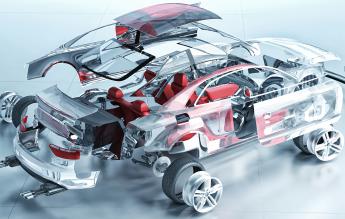
Our chassis dynamometer allows us to carry out emissions measurements as defined in the Euro 6 (but also WLTP) standards and measurement protocols.
Our chassis dynamometer meets the accuracy and reproducibility requirements of emissions measurements allowing vehicles to be tested under accurately simulated road conditions while remaining within the laboratory. The chassis dynamometer must exceed the demanding performance criteria required by US EPA, FTP 75 / SFTP (US06) EUDC guidelines (accurate road law simulation, fast and critically damped inertia simulation response to provide realistic GMP loading, accurate synchronization of multi-roller systems to ensure road-like conditions...)
Our facility allows for temperature and hydrometric control within the test chamber. It offers the possibility to change the force applied to the wheels, to control the ventilation of the grille, is equipped to measure the pollutants emitted and/or to quantify the electrical autonomy of the vehicle (via a dilution system and gas analysis bays). It allows tests at constant speed but also to play different cycles (WLTC, American cycles, Japanese cycles...)
Our main test bench is intended for light vehicles (thermal, hybrid, electric) or LDV (Light Duty Vehicle) which includes the M1 and N1 categories (with the possibility of approving N2 vehicles by following the exemptions). Within the framework of recent measurement protocols such as Euro 6, measurements on roller benches are supplemented by measurements in real driving conditions - RDE (Real Driving Emission), measurements carried out with PEMS .
Description of the bench and the associated instrumentation
In addition
The emissions of road transport are of two types:
Les essais d’émissions consistent à mesurer sur banc à rouleau les émissions de gaz polluants suivants : CO (monoxyde de carbone), THC - (hydrocarbure - total), NMHC (hydrocarbure non-méthanique), NOx (oxydes d’azote) avec PM qui exprime la masse particulaireet PN le nombre de particules.
Introduced from September 2017 for new types of vehicles and generalized in September 2019 for all vehicles, the Euro 6d-TEMP regulation introduces the measurement of pollutant emission levels in real life situation on open road, called RDE. This measure aims to reduce the gap between type approval and real-life use to ensure low real-life emission levels.
| Euro 6b | Euro 6d temp | Euro 6c | Euro 6d Full | |
| Homologation cycle |
NEDC | WLTC | ||
| Conformity factor Nox RDE | - | 2.1 | 1.5 | |
| Diesel engine | ||||
| Nox - Nitrogen oxid emission (mg/km) | 80 | |||
| CO - Carbon monoxide emission(mg/km) | 500 | |||
| HC Hydrocarbure emission (mg/km) | - | |||
| HCNM - Non-methane hydrocarbon emission (mg/km) | - | |||
| HC+Nox Emission (mg/km) | 170 | |||
| Particle matter emission in mass PM (mg/km) | 4.5 | |||
| Particle matter emission in number PN (Nbre/km) | 6x1011 | |||
| Gazoline engine | ||||
| Nox - Nitrogen oxid emission (mg/km) | 60 | |||
| CO - Carbon monoxide emission(mg/km) | 1000 | |||
| HC Hydrocarbure emission (mg/km) | 100 | |||
| HCNM - Non-methane hydrocarbon emission (mg/km) | 68 | |||
| HC+Nox Emission (mg/km) | - | |||
| Particle matter emission in mass PM (mg/km) | 5 | 4.5 | ||
| Particle matter emission in number PN (Nbre/km) | 6x1012 | 6x1011 | ||
The roller bench consists of a buried roller of high inertia, an electric load machine coupled to the roller and a computerized cycle monitoring device.
The driving wheels of the vehicle are placed on the roller, the other wheels are blocked, the vehicle is strapped to ensure the safety of the whole.
The principle of the measurement is to reproduce a driving profile (speed, acceleration...) as a function of time according to a predefined cycle, the load machine reproducing the simulated resistant forces of the vehicle.
At the same time, a measuring device allows to measure the regulated pollutants (CO, HC, Nox and particles), to calculate the fuel consumption and to take samples for the analysis of other pollutants (PAH, VOC...)
During the cycle, exhaust gas sampling is necessary for analysis. The sampling systems are based on the sampling of a sample in a constant gas flow. This system based on constant volume sampling of the diluted exhaust gas is called CVS (Constant Volume Sampling) or variable flow sampling.
A set of pumps is used to continuously collect constant fractions of diluted exhaust gas and dilution air in bags.
At the end of the test, the content of each bag, whose composition is representative of the whole gas sampled, is analyzed in order to determine the average percentages of the various pollutants.
The main forces at play during the progress of a vehicle are the forces related to aerodynamics, rolling, the road profile and the acceleration or deceleration of the vehicle.
These driving resistance parameters are taken into account according to the WLTP method following a maceration phase (vehicle stabilization: T, P, battery charge, etc.) at the test temperature of at least 8 hours.
For internal combustion vehicles, the test consists of a WLTC driving cycle.
For a majority of vehicles, class 3 of the WLTC cycle is used (those with a power density Pm > 34 W/kg) which includes 4 phases of low, medium, high and extra high speed (if the maximum speed of the vehicle is less than 135 km/h, the very high speed part is replaced by the low speed part) allowing to retranscribe driving conditions in urban and extra-urban part.
WLTC Class 3b (wikipedia)
For hybrid vehicles, the range of the vehicle in purely electric mode must be taken into account in order to define the rate of use of the electric motor. The values for pollutant emissions, CO2 emissions and fuel consumption are weighted according to this factor.
These hybrid vehicles perform the test several times.
This multi-stage measurement not only allows a more accurate determination of the fuel consumption and CO2 emissions, but also the electric range and the total range.
The CO2 value to be determined is then calculated as the ratio of electric range to total range.
A utility factor (UF) determines the utilization rate of the electric motor.
The UF represents the proportion of the distance covered by the vehicle in electric mode. For pure electric vehicles, the UF is 100%. In the case of traditional internal combustion engines, the UF is 0%. In the case of plug-in hybrids, the UF increases with their electric range. The UF can be used to evaluate the ability of a vehicle to run emission-free.
For electric vehicles, the measurement is made with the battery fully charged at the start of the test bench. Immediately after the test, the vehicle is reconnected to a charger. The cable is equipped with an electric meter. This meter measures the total amount of current, which has the advantage of also detecting the energy loss of the battery during charging. The value obtained is divided by the range determined during the bench test.













Emitech Group - Legal information